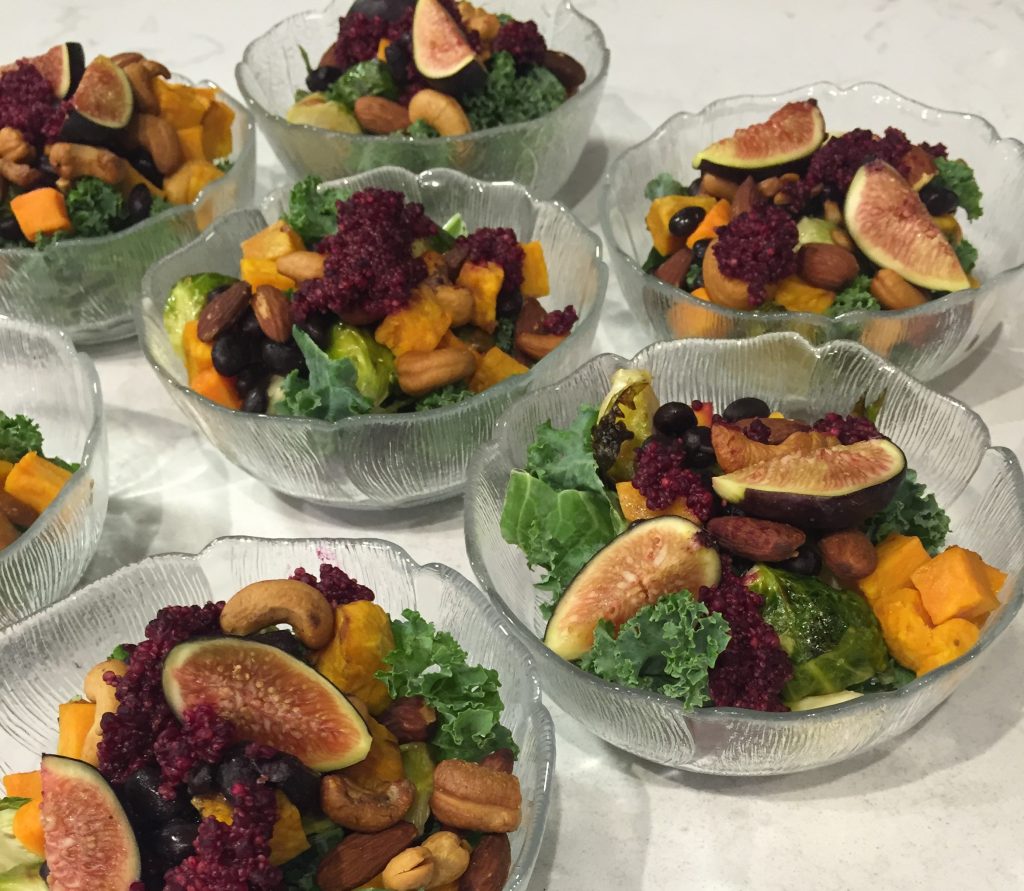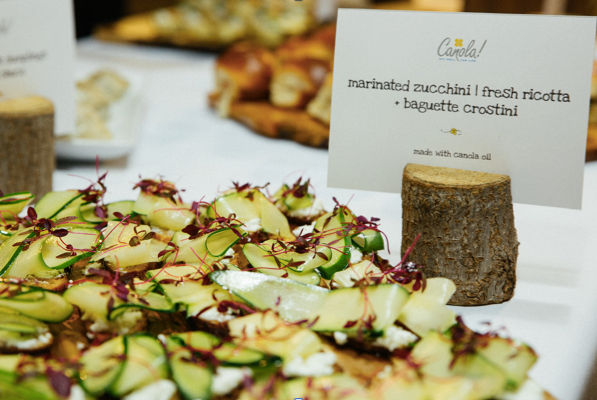
I’m a life longer learner and passionate about eating, delicious wholesome food! So when I was invited to a Love Your Heart – #CanolaConnect Culinary Workshop hosted by Canola Eat Well, I immediately jumped at the opportunity! It was an evening of learning, cooking, tasting and networking. Here are the event highlights!

A fun evening of learning with my dietitian buddies! Photography by Josh-Tenn Yuk courtesy of Canola Eat Well.
The Fabulous Food
The evening began with a spread of delicious appetizers ranging from Beef Tartine on Marble Rye with Hummus and Marinated Feta to Pommes Anna with Anchovy Chili and Cured Yolk. My hands down fave was the Marinated Zucchini with Fresh Ricotta served on a Baguette Crostini. What a winner – super presentation, a combo of textures and made with canola oil! Confession – I went back for seconds!

One of many tasty appetizers! Photography by Josh-Tenn Yuk courtesy of Canola Eat Well.
The Creative Chef
I was absolutely thrilled to meet Alexandra Feswick, Executive Chef at the Drake Hotel in Toronto! Inspired by local ingredients, Chef Alexandra created this gorgeous Power Bowl that’s bursting with flavour, colour and heart healthy goodness. “The combination of veggies is endless,” says Chef Alexandra whose salad bowl includes kale, Brussels sprouts, beets, sweet potatoes, avocado, figs and black beans.

Chef Alexandra Feswick. Photography by Josh-Tenn Yuk courtesy of Canola Eat Well.

Chef Alexandra’s Power Bowl! Photography by Sue Mah
We made our own salad dressing using the star ingredient – canola oil – and mixed in a blend of fresh herbs. With a neutral flavour, canola oil absorbs the flavours of herbs and spices, making it so versatile for salad dressings, baking, barbecuing and cooking. Chef Alexandra’s advice on food? “If you source ingredients properly, food should taste the way it’s meant to taste. And I really encourage people to experiment, after all, it’s just food!”

Mixing our own salad dressings. Photography by Josh-Tenn Yuk courtesy of Canola Eat Well.
Power Bowl with Green Goddess Dressing
Recipe by Chef Alexandra Feswick, Executive Chef at Drake Hotel
Green Goddess Dressing
1 tsp lemon juice
¼ tsp Dijon mustard
2 Tbsp canola oil
1 Tbsp crème fraiche
½ tsp garlic minced
1 Tbsp chopped herbs (chives, tarragon, parsley, mint, cilantro)
1. Combine lemon juice, Dijon mustard + canola oil together until well combined.
2. Add in crème fraiche + garlic and mix.
3. Gently add in mixed herbs and fold into the rest of the mixture.
Power Bowl
1 cup chopped kale
1 Tbsp black beans
1 Tbsp Brussels sprouts, roasted w canola oil
1 Tbsp chopped beets, cooked
1 Tbsp diced sweet potato, roasted w canola oil
1 Tbsp amaranth seeds, cooked
1 tsp almonds, roasted with canola oil
1 tsp cashews, roasted with canola oil
½ avocado
½ fig
1. Marinate kale with Green Goddess dressing.
2. Add in the remaining ingredients and toss together.
3. Enjoy!
The Passionate Farmer
Meet Jeanette Andrashewski, a canola farmer on a third generation farm in Two Hills, Alberta (about 140 km outside of Edmonton). As one of the 43,000 canola farmers in Canada, Jeanette takes pride in producing a Canadian product. When asked why she farms, her answer is honest and honourable, “We get to be our own boss and we get to feed the world.” Rotating through other crops such as wheat, barley and peas helps to keep Jeanette’s farmland healthy, “We want our food to be safe, affordable and nutritious. Our canola oil is going to your family.”

Farmer Jeanette cares about producing safe, affordable and nutritious food. Photography by Josh-Tenn Yuk courtesy of Canola Eat Well.
The Research Dietitian
Shaunda Durance-Tod reminded us of the many nutrition and health benefits of canola oil. For starters, canola oil is low in saturated fat and packed with heart healthy omega-3 fats and monounsaturated fats. Plus it’s a good source of vitamin E and vitamin K.

Dietitian Shaunda. Photography by Sue Mah
The Fun & Love
Put 26 dietitians in a beautiful, spacious venue at Luxe Appliance Studio, and you’re bound to get great laughs and inspiration! In honour of Heart Month, we were asked to share how we love our hearts. Chef Alexandra goes for a run. Farmer Jeanette practises meditation. Dietitian Shaunda stays calm. And me? I wake up with a heart full of gratitude and practise yoga daily! What about you? How do you love your heart?

Fun and friendship at the Luxe Appliance Studio. Photography by Josh-Tenn Yuk courtesy of Canola Eat Well.
Disclosure: #CanolaConnect was a sponsored event for dietitians and this is a sponsored post. All thoughts and opinions are my own.



















 [Thrilled to meet Chef Michael Smith!]
[Thrilled to meet Chef Michael Smith!]

